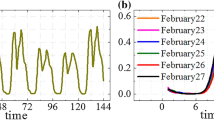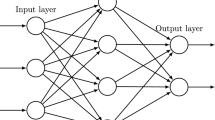Abstract
The optimization of mobile network capacity usage is an essential operation to promote positive returns on network investments, prevent capacity bottlenecks, and deliver good end user experience. This study examines the performance of several statistical models to predict voice and data traffic in a mobile network. While no method dominates the others across all time series and prediction horizons, exponential smoothing and ARIMA models are good alternatives to forecast both voice and data traffic. This analysis shows that network managers have at their disposal a set of statistical tools to plan future capacity upgrades with the most effective solution, while optimizing their investment and maintaining good network quality.









Similar content being viewed by others
Notes
For instance, a simple neural network, such as a multilayer perceptron with a single hidden layer, 7 inputs (one week of data), 7 hidden neurons and 1 output neuron will have \((7+1) \times 7 + (7+1) = 64\) parameters. Since the data have about 300 observations, only about 5 observations will be available to estimate each parameter.
This procedure is called “handover”.
Typically, mobile network operators do not store daily aggregated data for much longer periods due to storage limitations.
This is probably related to the lower levels of activity at work places during Friday afternoons.
There is some empirical evidence that a simple average of individual forecasts performs better than more sophisticated combination methods [27].
References
Cisco (2017). Cisco visual networking index: Forecast and methodology. 2016–2021.
Makridakis, S., & Hibon, M. (2000). The M-3 Competition: Results, conclusions, and implications. International Journal of Forecasting, 16, 451–476.
Meade, N., & Islam, T. (2015). Forecasting in telecommunications and ICT- A review. International Journal of Forecasting, 31, 1105–1126.
Frank, L. D. (2014). An analysis of the effect of the economic situation on modeling and forecasting the diffusion of wireless communications in Finland. Technological Forecasting and Social Change, 71, 391–493.
Michalakelis, C., Dede, G., Varoutas, D., & Sphicopoulos, T. (2008). Impact of cross-national diffusion process in telecommunications demand forecasting. Telecommunication Systems, 39, 51–60.
Wu, F.-S., & Chu, W.-L. (2010). Diffusion models of mobile telephony. Journal of Business Research, 63, 497–501.
Lee, M., & Cho, Y. (2007). The diffusion of mobile telecommunications services in Korea. Applied Economics Letters, 14, 477–481.
Christodoulos, C., Michalakelis, C., & Varoutas, D. (2010). Forecasting with limited data: Combining ARIMA and diffusion models. Technological Forecasting and Social Change, 77, 558–565.
Christodoulos, C., Michalakelis, C., & Varoutas, D. (2011). On the combination of exponential smoothing and diffusion forecasts: An application to broadbrad difussion in the OECD area. Technological Forecasting and Social Change, 78, 163–170.
Grambsch, P., & Stahel, W. A. (1990). Forecasting demand for special telephone services—a case study. International Journal of Forecasting, 6, 53–64.
Gardner, E. S., & Diaz-Saiz, J. (2008). Exponential smoothing in the telecommunications data. International Journal of Forecasting, 24, 170–174.
Fildes, R. (1992). The evaluation of extrapolative forecasting methods. International Journal of Forecasting, 8, 81–98.
Madden, G., Savage, S. J., & Coble-Neal, G. (2002). Forecasting United States—Asia international message telephone service. International Journal of Forecasting, 18, 523–543.
Madden, G., & Coble-Neal, G. (2005). Forecasting international bandwidth capability. Journal of Forecasting, 24, 299–309.
Madden, G., & Tan, J. (2008). Forecasting international bandwidth capacity using linear and ANN methods. Applied Economics, 40, 1775–1787.
Guo, J., Peng Y., Peng, X., Chen, Q., Yu, J. & Dai, Y. (2009). Traffic forecasting for mobile networks with multiplicative seasonal ARIMA models: Proceedings of the 9th International Conference on Electronic Measurement and Instruments.
Pan, H., Liu, J., Zhou, S. & Niu, Z. (2015). A block regression model for short-term mobile traffic forecasting: Proceeding of the 2015 IEEE/CIC International Conference on Communications in China.
Tikunov, D. & Nishimura, T. (2007). Traffic prediction for mobile network using Holt–Winter’s exponential smoothing: Proceedings of the 15th International Conference on Software, Telecommunications and Computer Networks.
Xu, F., Lin, Y., Huang, J., Wu, D., Shi, H., Song, J., et al. (2016). Big data driven mobile traffic understanding and forecasting: A time series approach. IEEE Transactions on Services Computing, 9, 796–805.
Hyndman, R.J., O’Hara-Wild, M., Bergmeir, C., & Razbash, S. (2017). Package ‘forecast’, September 25, 2017.
Gardner, E. S, Jr. (2006). Exponential smoothing: The state of the art—Part II. International Journal of Forecasting, 22, 637–666.
Gardner, E. S, Jr., & McKenzie, E. (1989). Seasonal exponential smoothing with damped trends. Management Science, 35, 372–376.
Hyndman, R.J., & Khandakar, Y. (2008). Automatic time series forecasting: The forecast package for R. Journal of Statistical Software, 26.
Assimakopoulos, V., & Nikolopoulos, K. (2000). The theta model: A decomposition approach to forecasting. International Journal of Forecasting, 16, 521–530.
Hyndman, R. J., & Billah, B. (2003). Unmasking the theta method. International Journal of Forecasting, 19, 287–290.
Timmermann, A. (2006). Forecast combinations. In G. Elliott, C. W. J. Granger, & A. Timmermann (Eds.), Handbook of Economic Forecasting (pp. 135–196). Amsterdam: Elsevier Press.
Stock, J. H., & Watson, M. W. (2001). A comparison of linear and nonlinear univariate models for forecasting macroeconomic time series. In R. F. Engle & H. White (Eds.), Festschrift in Honour of Clive Granger (pp. 1–44). Cambridge: Cambridge University Press.
Bergmeir, C., Hyndman, R. J., & Benítez, J. M. (2016). Bagging exponential smoothing methods using STL decomposition and Box–Cox transformation. International Journal of Forecasting, 32, 303–312.
Breiman, L. (1996). Bagging predictors. Machine Learning, 24, 123–140.
Author information
Authors and Affiliations
Corresponding author
Ethics declarations
Conflict of interest
The corresponding author states that there is no conflict of interest.
Additional information
Publisher's Note
Springer Nature remains neutral with regard to jurisdictional claims in published maps and institutional affiliations.
Rights and permissions
About this article
Cite this article
Bastos, J.A. Forecasting the capacity of mobile networks. Telecommun Syst 72, 231–242 (2019). https://doi.org/10.1007/s11235-019-00556-w
Published:
Issue Date:
DOI: https://doi.org/10.1007/s11235-019-00556-w




